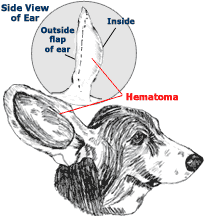
Ear Hematomas
An ear hematomas is a firm fluid-filled swollen mass that is visible on the inside of the earflap. Usually the dog will get an ear hematomas from shakng its head or scratching its ear because it has an underlying allergy or ear disease. The scratching or shaking of the ear ruptuers the tiny blood vessels in the ear's cartilage causing them to bleed under the skin of the earflap forming a pocket of blood.

Occasionally the ermatomas is caused by a dog fight where the fight has caused ruture of the blood vessels. Others causes include an infection or inflamation of the ear, the precence of a forgeign body or ear parasite. These all cause pain, itchiness or irritation that a dog would seek to allec\viate by shaking or scratching.
There are several procedures for treating aural hematomas the approach will depend on the severity of the dogs condition. One method involves the placing of a drain securely into thr tip of the ear allowing the fluid to drain. This is left in place for 2-3 weks as the ear flap seals
Another method performed under general anaesthesia involves making a surgical incision into the swelling on the ear allowing the fluid to drain. Then multiple sutures are stitched into the ear to seal it back together. After about 7-10 days following the procedure after the ear has drained and healed fully the sutures will be removed.
Failure to treat a hematomas can lead to enlargement of theswelling to encompass the entire ear flap. Also scars tissue formation within the hematomas will result in a severly wrinkled thickened black earflap that will predispose the dog to further ear problems.
To help prevent ear hematomas formation it is essential that we determine what is causing the irriation that is making the dog shake its head or scratch its ears.
A thorough examination of the ear will be necessary. When the dog is brought to the clinic we may use an otoscopes to look down into the ear canals to determine the presence of a forgeign body or inflamation in the ears. Ear swabs often are taken and the material is evaluated under the microscope to look for causes of otitis such as yeast ear mite or bacterias. Allergies also cause irriation to the ears. Wound of the pinna or earflap should be treated to prevent traumato the ear caused by shaking and scratching.